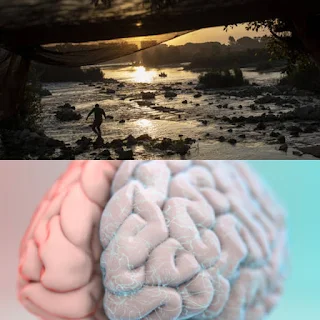Professor of Water Resources and Irrigation at Cairo University, Abbas Sharaqi, revealed important secrets about the discovery of the ancient bottom of the Nile River, according to the scientific magazine IFLScience.
Sharaqi said in statements to RT: “The geological history of the Nile River dates back more than 20 million years, and it began with separate rivers within Egypt, most of which originate from the Red Sea mountains in rainy times, where ancient rivers formed the current valleys, such as Qena, which originates from the Red Sea mountains and heads south.” Towards Qena, then Aswan, the Toshka Depressions, and north to the Kharga Oases until it reaches the Siwa Oasis and the Qattara Depression.
Sharaqi continued: “Then these rivers united to flow into the Mediterranean Sea before connecting with the Ethiopian and Sudanese rivers about 6 million years ago to take its current form. In the Nile Delta, water flows over the flat area and forms seven main branches of the eastern delta, one of which was making its way east of the delta to the Al-Tina Plain.” In Sinai (before the Suez Canal), five branches have disappeared as a result of the accumulation of silt, especially in years of floods, while the Damietta and Rosetta branches have remained intact until now.
Sharaqi noted that in a recent study, through remote sensing using radar rays that can penetrate the disintegrated surface layer and then bounce back from the bottom of valleys or ancient rivers, announcing the presence of ancient branches, in this way it was possible to determine the paths of ancient rivers in the Western Desert, most of which are covered with sand. Currently, the discovered branch is an ancient branch extending from Fayoum to Giza, and studies are underway to determine whether it existed in the era of building the pyramids, and whether it was used to transport stones from Aswan?
He emphasized that about 160 years ago, Al-Haram Street was a canal from the Nile that was filled in with urban growth and the disappearance of agricultural lands, as happened recently to some canals, such as Al-Zumar Canal at the beginning of Al-Haram Street.
The branch of the Nile River previously passed through the Giza area, but it dried up completely. Dr. Iman Ghoneim, a specialist in remote Earth sensing in the United States, was able to discover the arms of the ancient Nile, using data received from a radar satellite to study the Nile valleys from space. Space radar data revealed a hidden, invisible world of information hiding beneath the Earth's surface.
He showed the long-dried bed of the Nile River, whose channels meandered through the desert, in radar images. Its length reached 100 kilometers.
Ghoneim said: “The length of the canals was not only great, but their width was also great. We are talking about half a kilometer or more, which is equivalent to the width of the main canal of the Nile River today.”
The now-vanished waterway ran from Fayoum to Giza and passed through 38 remaining pyramids. Therefore, it was called the “Pyramids Branch.” The team of scientists now wants to analyze soil samples to determine whether these arms existed in the era of the Old and Middle Kingdoms (3,700 to 4,700 years ago) when the pyramids were built.
According to the testimony of the participants, a brain transplant achieved overwhelming success!
A brain implant designed for head injury patients has achieved great success during trials, as participants refused to turn off the implanted device.
Created by researchers at Stanford University, deep brain stimulation attempts to boost activity between areas of the brain responsible for memory, thinking, problem solving and conscious learning.
Five people suffering from head injuries reported that they were able to concentrate, remember, drive, and spend the day without the need for a nap, as a result of using the device during the experiment.
The device proved so effective that two participants, chosen at random, refused to turn off the device.
Participants in the experiment were selected based on their injuries, as the participants had previously recovered from a coma.
Dr Jamie Henderson, professor of neurosurgery, told The Telegraph: “In these patients, these pathways were largely intact, with everything regulated.”
By introducing electrical stimulation to specific areas of the brain, researchers hope to reactivate the pathways again. They used virtual models of each participant's brain to experience stimulation in different areas.
The devices were then implanted in the brains of participants between the ages of 22 and 60. They then spent 90 days with it running for 12 hours a day.
The researchers say that by the end of the experiment, participants' mental processing speeds had improved by an average of 32%.
One participant said that since receiving the implant, he has seen a significant improvement in his functional abilities.
The goal is to move the research from the “groundbreaking experimental moment” to actual treatment, said Dr. Nicholas Schiff, a professor at Weill Cornell Medical College and co-lead author of the study.






Good
ReplyDeleteInformative content.
ReplyDelete